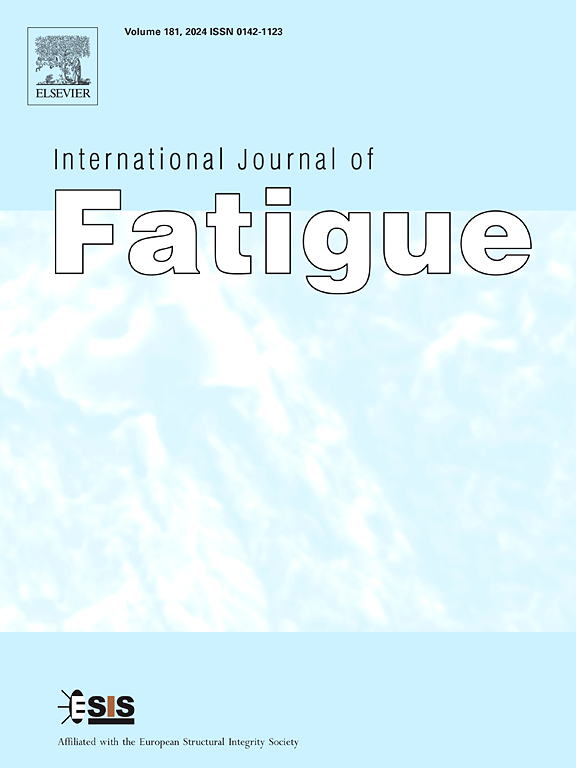Phase-field modeling of fatigue fracture in porous functionally graded materials
IF 5.7
2区 材料科学
Q1 ENGINEERING, MECHANICAL
引用次数: 0
Abstract
Porous Functionally Graded Materials (PFGM) exhibit complex damage behavior due to the presence of pores. This study presents a hybrid phase-field model to investigate fatigue crack growth in PFGM. The continuous variation of material properties is captured using the Voigt rule of mixtures with uniform porosity, while fatigue effects are incorporated through a fatigue degradation function in the energy functional. Using temperature as an analogous phase field parameter and adapting a staggered solution scheme to solve the coupled governing differential equations, the framework is implemented through a UMAT subroutine feature in ABAQUS. The methodology is validated with results available in the literature, demonstrating its accuracy and robustness. Numerical simulations explore the influence of porosity ratio, power law index, and material gradation on the fatigue fracture behavior under various loading conditions. From a systematic numerical study it is opined that higher porosity levels significantly influence crack propagation paths and load-bearing capacity. Understanding fatigue fracture in PFGM provides valuable insights for optimizing material selection, enhancing structural durability, and improving design strategies for fatigue-critical applications in aerospace and mechanical engineering.
多孔功能梯度材料疲劳断裂的相场模拟
多孔功能梯度材料(PFGM)由于孔隙的存在而表现出复杂的损伤行为。本文提出了一种混合相场模型来研究PFGM的疲劳裂纹扩展。材料性能的连续变化是使用具有均匀孔隙率的混合物的Voigt规则捕获的,而疲劳效应是通过能量泛函中的疲劳退化函数纳入的。该框架以温度为模拟相场参数,采用交错解法求解耦合控制微分方程,并通过ABAQUS中的UMAT子程序特征实现。该方法与文献中可用的结果进行了验证,证明了其准确性和稳健性。数值模拟研究了不同载荷条件下孔隙率、幂律指数和材料级配对疲劳断裂行为的影响。系统的数值研究表明,高孔隙率对裂纹扩展路径和承载能力有显著影响。了解PFGM的疲劳断裂为优化材料选择、提高结构耐久性以及改进航空航天和机械工程中疲劳关键应用的设计策略提供了有价值的见解。
本文章由计算机程序翻译,如有差异,请以英文原文为准。
求助全文
约1分钟内获得全文
求助全文
来源期刊

International Journal of Fatigue
工程技术-材料科学:综合
CiteScore
10.70
自引率
21.70%
发文量
619
审稿时长
58 days
期刊介绍:
Typical subjects discussed in International Journal of Fatigue address:
Novel fatigue testing and characterization methods (new kinds of fatigue tests, critical evaluation of existing methods, in situ measurement of fatigue degradation, non-contact field measurements)
Multiaxial fatigue and complex loading effects of materials and structures, exploring state-of-the-art concepts in degradation under cyclic loading
Fatigue in the very high cycle regime, including failure mode transitions from surface to subsurface, effects of surface treatment, processing, and loading conditions
Modeling (including degradation processes and related driving forces, multiscale/multi-resolution methods, computational hierarchical and concurrent methods for coupled component and material responses, novel methods for notch root analysis, fracture mechanics, damage mechanics, crack growth kinetics, life prediction and durability, and prediction of stochastic fatigue behavior reflecting microstructure and service conditions)
Models for early stages of fatigue crack formation and growth that explicitly consider microstructure and relevant materials science aspects
Understanding the influence or manufacturing and processing route on fatigue degradation, and embedding this understanding in more predictive schemes for mitigation and design against fatigue
Prognosis and damage state awareness (including sensors, monitoring, methodology, interactive control, accelerated methods, data interpretation)
Applications of technologies associated with fatigue and their implications for structural integrity and reliability. This includes issues related to design, operation and maintenance, i.e., life cycle engineering
Smart materials and structures that can sense and mitigate fatigue degradation
Fatigue of devices and structures at small scales, including effects of process route and surfaces/interfaces.
 求助内容:
求助内容: 应助结果提醒方式:
应助结果提醒方式:


